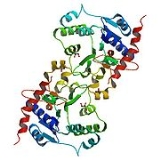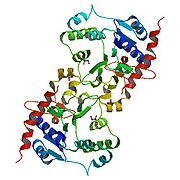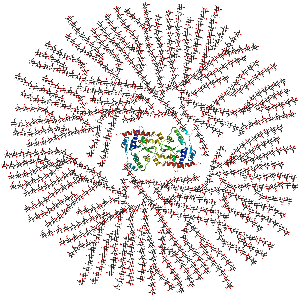
Glycogenin
Encyclopedia

Enzyme
Enzymes are proteins that catalyze chemical reactions. In enzymatic reactions, the molecules at the beginning of the process, called substrates, are converted into different molecules, called products. Almost all chemical reactions in a biological cell need enzymes in order to occur at rates...
involved in converting glucose
Glucose
Glucose is a simple sugar and an important carbohydrate in biology. Cells use it as the primary source of energy and a metabolic intermediate...
to glycogen
Glycogen
Glycogen is a molecule that serves as the secondary long-term energy storage in animal and fungal cells, with the primary energy stores being held in adipose tissue...
. It acts as a primer
Primer (molecular biology)
A primer is a strand of nucleic acid that serves as a starting point for DNA synthesis. They are required for DNA replication because the enzymes that catalyze this process, DNA polymerases, can only add new nucleotides to an existing strand of DNA...
, by polymerizing the first few glucose molecules, after which other enzymes take over.
In humans, there are two isoforms
Protein isoform
A protein isoform is any of several different forms of the same protein. Different forms of a protein may be produced from related genes, or may arise from the same gene by alternative splicing. A large number of isoforms are caused by single-nucleotide polymorphisms or SNPs, small genetic...
of glycogenin — glycogenin-1, encoded by GYG1, and expressed in muscle; and glycogenin-2, encoded by GYG2,and expressed in the liver and cardiac muscle, but not skeletal muscle. Patients have been found with defective GYG1, resulting in muscle cells with the inability to store glycogen, and consequential weakness and heart disease.
Glycogenin was discovered by Dr. William J. Whelan, a fellow of the Royal Society of London and current professor of Biochemistry at the University of Miami
University of Miami
The University of Miami is a private, non-sectarian university founded in 1925 with its main campus in Coral Gables, Florida, a medical campus in Miami city proper at Civic Center, and an oceanographic research facility on Virginia Key., the university currently enrolls 15,629 students in 12...
. It is a homodimer of 37-kDa
Atomic mass unit
The unified atomic mass unit or dalton is a unit that is used for indicating mass on an atomic or molecular scale. It is defined as one twelfth of the rest mass of an unbound neutral atom of carbon-12 in its nuclear and electronic ground state, and has a value of...
subunits and is classified as a glycosyltransferase
Glycosyltransferase
Glycosyltransferases are enzymes that act as a catalyst for the transfer of a monosaccharide unit from an activated nucleotide sugar to a glycosyl acceptor molecule, usually an alcohol....
.
Function
The main enzyme involved in glycogen polymerisation, glycogen synthaseGlycogen synthase
Glycogen synthase is an enzyme involved in converting glucose to glycogen. It takes short polymers of glucose and converts them into long polymers....
, can only add to an existing chain of at least 4 glucose
Glucose
Glucose is a simple sugar and an important carbohydrate in biology. Cells use it as the primary source of energy and a metabolic intermediate...
residues. Glycogenin acts as the primer
Primer (molecular biology)
A primer is a strand of nucleic acid that serves as a starting point for DNA synthesis. They are required for DNA replication because the enzymes that catalyze this process, DNA polymerases, can only add new nucleotides to an existing strand of DNA...
, to which further glucose monomer
Monomer
A monomer is an atom or a small molecule that may bind chemically to other monomers to form a polymer; the term "monomeric protein" may also be used to describe one of the proteins making up a multiprotein complex...
s may be added. It achieves this by catalyzing
Catalysis
Catalysis is the change in rate of a chemical reaction due to the participation of a substance called a catalyst. Unlike other reagents that participate in the chemical reaction, a catalyst is not consumed by the reaction itself. A catalyst may participate in multiple chemical transformations....
the addition of glucose to itself (autocatalysis) by first binding glucose from UDP-glucose to the hydroxyl
Hydroxyl
A hydroxyl is a chemical group containing an oxygen atom covalently bonded with a hydrogen atom. In inorganic chemistry, the hydroxyl group is known as the hydroxide ion, and scientists and reference works generally use these different terms though they refer to the same chemical structure in...
group of Tyr-194. Seven more glucoses can be added, each derived from UDP-glucose, by glycogenin's glucosyltransferase activity. Once sufficient residues have been added, glycogen synthase takes over extending the chain. Glycogenin remains covalently attached to the reducing end of the glycogen molecule
Molecule
A molecule is an electrically neutral group of at least two atoms held together by covalent chemical bonds. Molecules are distinguished from ions by their electrical charge...
.
Evidence accumulates that a priming protein may be a fundamental property of polysaccharide synthesis in general; the molecular details of mammalian glycogen biogenesis may serve as a useful model for other systems.
Structure


